MA5-12808
antibody from Invitrogen Antibodies
Targeting: MAPT
DDPAC, FLJ31424, FTDP-17, MAPTL, MGC138549, MSTD, MTBT1, MTBT2, PPND, PPP1R103, tau
Antibody data
- Antibody Data
- Antigen structure
- References [92]
- Comments [0]
- Validations
- Immunocytochemistry [2]
- Immunoprecipitation [1]
- Immunohistochemistry [2]
- Other assay [8]
Submit
Validation data
Reference
Comment
Report error
- Product number
- MA5-12808 - Provider product page

- Provider
- Invitrogen Antibodies
- Product name
- Tau Monoclonal Antibody (TAU-5)
- Antibody type
- Monoclonal
- Antigen
- Purifed from natural sources
- Description
- MA5-12808 targets TAU in immunofluorescence, immunoprecipitation, and Western blot applications and shows reactivity with Bovine, Human, mouse, Ovine, and Rat samples. The MA5-12808 immunogen is purified bovine microtubule-associated proteins.
- Reactivity
- Human, Mouse, Rat, Bovine
- Host
- Mouse
- Isotype
- IgG
- Antibody clone number
- TAU-5
- Vial size
- 100 μg
- Concentration
- 0.5 mg/mL
- Storage
- -20°C
Submitted references Host Tau Genotype Specifically Designs and Regulates Tau Seeding and Spreading and Host Tau Transformation Following Intrahippocampal Injection of Identical Tau AD Inoculum.
Effects of Chronic Secondhand Smoke (SHS) Exposure on Cognitive Performance and Metabolic Pathways in the Hippocampus of Wild-Type and Human Tau Mice.
Retinal ganglion cell loss in an ex vivo mouse model of optic nerve cut is prevented by curcumin treatment.
The extracellular chaperone Clusterin enhances Tau aggregate seeding in a cellular model.
Icariin protects against sodium azide-induced neurotoxicity by activating the PI3K/Akt/GSK-3β signaling pathway.
Disease-Associated Mutant Tau Prevents Circadian Changes in the Cytoskeleton of Central Pacemaker Neurons.
Protocol for High-Throughput Screening of Neural Cell or Brain Tissue Protein Using a Dot-Blot Technique with Near-Infrared Imaging.
Tau is not necessary for amyloid-β-induced synaptic and memory impairments.
Yeast surface display of full-length human microtubule-associated protein tau.
Tau-Mediated Disruption of the Spliceosome Triggers Cryptic RNA Splicing and Neurodegeneration in Alzheimer's Disease.
NLRP3 inflammasome activation drives tau pathology.
Effects of APOE Genotype on Brain Proteomic Network and Cell Type Changes in Alzheimer's Disease.
Quantitative Analysis of the Brain Ubiquitylome in Alzheimer's Disease.
Oxidative Stress Modifies the Levels and Phosphorylation State of Tau Protein in Human Fibroblasts.
Open-gate mutants of the mammalian proteasome show enhanced ubiquitin-conjugate degradation.
β-Secretase 1's Targeting Reduces Hyperphosphorilated Tau, Implying Autophagy Actors in 3xTg-AD Mice.
The domestic cat as a natural animal model of Alzheimer's disease.
Berberine attenuates axonal transport impairment and axonopathy induced by Calyculin A in N2a cells.
Long- and short-term CDK5 knockdown prevents spatial memory dysfunction and tau pathology of triple transgenic Alzheimer's mice.
Tau reduction prevents disease in a mouse model of Dravet syndrome.
Long-term treadmill exercise attenuates tau pathology in P301S tau transgenic mice.
A protocol for concurrent high-quality immunohistochemical and biochemical analyses in adult mouse central nervous system.
Activation of sirtuin 1 attenuates cerebral ventricular streptozotocin-induced tau hyperphosphorylation and cognitive injuries in rat hippocampi.
Alzheimer's disease related markers, cellular toxicity and behavioral deficits induced six weeks after oligomeric amyloid-β peptide injection in rats.
Nmnat2 attenuates Tau phosphorylation through activation of PP2A.
Generation and characterization of a rabbit monoclonal antibody site-specific for tau O-GlcNAcylated at serine 400.
Glycation exacerbates the neuronal toxicity of β-amyloid.
Ser9 phosphorylation causes cytoplasmic detention of I2PP2A/SET in Alzheimer disease.
Overexpression of RCAN1 isoform 4 in mouse neurons leads to a moderate behavioral impairment.
NMDA receptor subunit composition determines beta-amyloid-induced neurodegeneration and synaptic loss.
Bip enhanced the association of GSK-3β with tau during ER stress both in vivo and in vitro.
Expression of the hyperphosphorylated tau attenuates ER stress-induced apoptosis with upregulation of unfolded protein response.
Central angiotensin II-induced Alzheimer-like tau phosphorylation in normal rat brains.
Tumor necrosis factor-α synthesis inhibitor 3,6'-dithiothalidomide attenuates markers of inflammation, Alzheimer pathology and behavioral deficits in animal models of neuroinflammation and Alzheimer's disease.
Targeting hyperphosphorylated tau with sodium selenate suppresses seizures in rodent models.
A proteomic analysis of MCLR-induced neurotoxicity: implications for Alzheimer's disease.
AGEs induce Alzheimer-like tau pathology and memory deficit via RAGE-mediated GSK-3 activation.
Neuroglobin attenuates Alzheimer-like tau hyperphosphorylation by activating Akt signaling.
Methylglyoxal induces tau hyperphosphorylation via promoting AGEs formation.
Enriched environment prevents cognitive impairment and tau hyperphosphorylation after chronic cerebral hypoperfusion.
Enriched environment prevents cognitive impairment and tau hyperphosphorylation after chronic cerebral hypoperfusion.
The protein phosphatase PP2A/Bα binds to the microtubule-associated proteins Tau and MAP2 at a motif also recognized by the kinase Fyn: implications for tauopathies.
Folate/vitamin-B12 prevents chronic hyperhomocysteinemia-induced tau hyperphosphorylation and memory deficits in aged rats.
Berberine attenuates calyculin A-induced cytotoxicity and Tau hyperphosphorylation in HEK293 cells.
Combined expression of tau and the Harlequin mouse mutation leads to increased mitochondrial dysfunction, tau pathology and neurodegeneration.
AMPK activation inhibits apoptosis and tau hyperphosphorylation mediated by palmitate in SH-SY5Y cells.
Fuzhisan, a Chinese herbal medicine, inhibits beta-amyloid-induced neurotoxicity and tau phosphorylation through calpain/Cdk5 pathway in cultured cortical neurons.
Inhibition of glycogen synthase kinase-3β by Angelica sinensis extract decreases β-amyloid-induced neurotoxicity and tau phosphorylation in cultured cortical neurons.
Mapping O-GlcNAc modification sites on tau and generation of a site-specific O-GlcNAc tau antibody.
Altered phosphorylation but no neurodegeneration in a mouse model of tau hyperphosphorylation.
Expression of the HFE allelic variant H63D in SH-SY5Y cells affects tau phosphorylation at serine residues.
LiCl attenuates thapsigargin-induced tau hyperphosphorylation by inhibiting GSK-3β in vivo and in vitro.
LiCl attenuates thapsigargin-induced tau hyperphosphorylation by inhibiting GSK-3β in vivo and in vitro.
Tau dephosphorylation potentiates apoptosis by mechanisms involving a failed dephosphorylation/activation of Bcl-2.
A comparative study of Lrrk2 function in primary neuronal cultures.
Protective effect of isoflavones against homocysteine-mediated neuronal degeneration in SH-SY5Y cells.
Inhibition of autophagy causes tau proteolysis by activating calpain in rat brain.
Isoflavones prevent endoplasmic reticulum stress-mediated neuronal degeneration by inhibiting tau hyperphosphorylation in SH-SY5Y cells.
Delphinidin ameliorates beta-amyloid-induced neurotoxicity by inhibiting calcium influx and tau hyperphosphorylation.
2,3,7,8-TCDD neurotoxicity in neuroblastoma cells is caused by increased oxidative stress, intracellular calcium levels, and tau phosphorylation.
Protective effect of caffeic acid against beta-amyloid-induced neurotoxicity by the inhibition of calcium influx and tau phosphorylation.
Three-dimensional neural constructs: a novel platform for neurophysiological investigation.
Estradiol attenuates tau hyperphosphorylation induced by upregulation of protein kinase-A.
Activation of glycogen synthase kinase-3 inhibits protein phosphatase-2A and the underlying mechanisms.
Enhanced activity of hippocampal BACE1 in a mouse model of postmenopausal memory deficits.
17beta-estradiol attenuates glycogen synthase kinase-3beta activation and tau hyperphosphorylation in Akt-independent manner.
Phosphorylated PP2A (tyrosine 307) is associated with Alzheimer neurofibrillary pathology.
Curcumin protected PC12 cells against beta-amyloid-induced toxicity through the inhibition of oxidative damage and tau hyperphosphorylation.
Up-regulation of tau, a brain microtubule-associated protein, in lens cortical fractions of aged alphaA-, alphaB-, and alphaA/B-crystallin knockout mice.
Efficacy of small-molecule glycogen synthase kinase-3 inhibitors in the postnatal rat model of tau hyperphosphorylation.
Caspase-3- and calpain-mediated tau cleavage are differentially prevented by estrogen and testosterone in beta-amyloid-treated hippocampal neurons.
Effects of tau phosphorylation on proteasome activity.
Lithium inhibits stress-induced changes in tau phosphorylation in the mouse hippocampus.
The involvement of glycogen synthase kinase-3 and protein phosphatase-2A in lactacystin-induced tau accumulation.
The marijuana component cannabidiol inhibits beta-amyloid-induced tau protein hyperphosphorylation through Wnt/beta-catenin pathway rescue in PC12 cells.
Alzheimer's disease-like tau neuropathology leads to memory deficits and loss of functional synapses in a novel mutated tau transgenic mouse without any motor deficits.
EWS-FLI1 fusion protein up-regulates critical genes in neural crest development and is responsible for the observed phenotype of Ewing's family of tumors.
Abnormal group I metabotropic glutamate receptor expression and signaling in the frontal cortex in Pick disease.
Abnormal group I metabotropic glutamate receptor expression and signaling in the frontal cortex in Pick disease.
Altered axonal architecture by removal of the heavily phosphorylated neurofilament tail domains strongly slows superoxide dismutase 1 mutant-mediated ALS.
Nitration and oligomerization of tau induced by peroxynitrite inhibit its microtubule-binding activity.
Mutations in the tau gene that cause an increase in three repeat tau and frontotemporal dementia.
Mutations in the tau gene that cause an increase in three repeat tau and frontotemporal dementia.
Partial rescue of the p35-/- brain phenotype by low expression of a neuronal-specific enolase p25 transgene.
Partial rescue of the p35-/- brain phenotype by low expression of a neuronal-specific enolase p25 transgene.
Cleavage of the cyclin-dependent kinase 5 activator p35 to p25 does not induce tau hyperphosphorylation.
Cleavage of the cyclin-dependent kinase 5 activator p35 to p25 does not induce tau hyperphosphorylation.
Rapid detection of protein aggregates in the brains of Alzheimer patients and transgenic mouse models of amyloidosis.
Rapid detection of protein aggregates in the brains of Alzheimer patients and transgenic mouse models of amyloidosis.
Hydrogen peroxide induces transient dephosphorylation of tau protein in cultured rat oligodendrocytes.
Hydrogen peroxide induces transient dephosphorylation of tau protein in cultured rat oligodendrocytes.
Reduced protein phosphatase 2A activity induces hyperphosphorylation and altered compartmentalization of tau in transgenic mice.
Andrés-Benito P, Carmona M, Jordán M, Fernández-Irigoyen J, Santamaría E, Del Rio JA, Ferrer I
International journal of molecular sciences 2022 Jan 10;23(2)
International journal of molecular sciences 2022 Jan 10;23(2)
Effects of Chronic Secondhand Smoke (SHS) Exposure on Cognitive Performance and Metabolic Pathways in the Hippocampus of Wild-Type and Human Tau Mice.
Raber J, Perez R, Torres ERS, Krenik D, Boutros S, Patel E, Chlebowski AC, Torres ER, Perveen Z, Penn A, Paulsen DB, Bartlett MG, Jia E, Holden S, Hall R, Morré J, Wong C, Ho E, Choi J, Stevens JF, Noël A, Bobe G, Kisby G
Environmental health perspectives 2021 May;129(5):57009
Environmental health perspectives 2021 May;129(5):57009
Retinal ganglion cell loss in an ex vivo mouse model of optic nerve cut is prevented by curcumin treatment.
Buccarello L, Dragotto J, Hassanzadeh K, Maccarone R, Corbo M, Feligioni M
Cell death discovery 2021 Dec 15;7(1):394
Cell death discovery 2021 Dec 15;7(1):394
The extracellular chaperone Clusterin enhances Tau aggregate seeding in a cellular model.
Yuste-Checa P, Trinkaus VA, Riera-Tur I, Imamoglu R, Schaller TF, Wang H, Dudanova I, Hipp MS, Bracher A, Hartl FU
Nature communications 2021 Aug 11;12(1):4863
Nature communications 2021 Aug 11;12(1):4863
Icariin protects against sodium azide-induced neurotoxicity by activating the PI3K/Akt/GSK-3β signaling pathway.
Zhang Y, Huang N, Lu H, Huang J, Jin H, Shi J, Jin F
PeerJ 2020;8:e8955
PeerJ 2020;8:e8955
Disease-Associated Mutant Tau Prevents Circadian Changes in the Cytoskeleton of Central Pacemaker Neurons.
Cassar M, Law AD, Chow ES, Giebultowicz JM, Kretzschmar D
Frontiers in neuroscience 2020;14:232
Frontiers in neuroscience 2020;14:232
Protocol for High-Throughput Screening of Neural Cell or Brain Tissue Protein Using a Dot-Blot Technique with Near-Infrared Imaging.
Chlebowski AC, Kisby GE
STAR protocols 2020 Sep 18;1(2)
STAR protocols 2020 Sep 18;1(2)
Tau is not necessary for amyloid-β-induced synaptic and memory impairments.
Puzzo D, Argyrousi EK, Staniszewski A, Zhang H, Calcagno E, Zuccarello E, Acquarone E, Fa' M, Li Puma DD, Grassi C, D'Adamio L, Kanaan NM, Fraser PE, Arancio O
The Journal of clinical investigation 2020 Sep 1;130(9):4831-4844
The Journal of clinical investigation 2020 Sep 1;130(9):4831-4844
Yeast surface display of full-length human microtubule-associated protein tau.
Wang S, Cho YK
Biotechnology progress 2020 Jan;36(1):e2920
Biotechnology progress 2020 Jan;36(1):e2920
Tau-Mediated Disruption of the Spliceosome Triggers Cryptic RNA Splicing and Neurodegeneration in Alzheimer's Disease.
Hsieh YC, Guo C, Yalamanchili HK, Abreha M, Al-Ouran R, Li Y, Dammer EB, Lah JJ, Levey AI, Bennett DA, De Jager PL, Seyfried NT, Liu Z, Shulman JM
Cell reports 2019 Oct 8;29(2):301-316.e10
Cell reports 2019 Oct 8;29(2):301-316.e10
NLRP3 inflammasome activation drives tau pathology.
Ising C, Venegas C, Zhang S, Scheiblich H, Schmidt SV, Vieira-Saecker A, Schwartz S, Albasset S, McManus RM, Tejera D, Griep A, Santarelli F, Brosseron F, Opitz S, Stunden J, Merten M, Kayed R, Golenbock DT, Blum D, Latz E, Buée L, Heneka MT
Nature 2019 Nov;575(7784):669-673
Nature 2019 Nov;575(7784):669-673
Effects of APOE Genotype on Brain Proteomic Network and Cell Type Changes in Alzheimer's Disease.
Dai J, Johnson ECB, Dammer EB, Duong DM, Gearing M, Lah JJ, Levey AI, Wingo TS, Seyfried NT
Frontiers in molecular neuroscience 2018;11:454
Frontiers in molecular neuroscience 2018;11:454
Quantitative Analysis of the Brain Ubiquitylome in Alzheimer's Disease.
Abreha MH, Dammer EB, Ping L, Zhang T, Duong DM, Gearing M, Lah JJ, Levey AI, Seyfried NT
Proteomics 2018 Oct;18(20):e1800108
Proteomics 2018 Oct;18(20):e1800108
Oxidative Stress Modifies the Levels and Phosphorylation State of Tau Protein in Human Fibroblasts.
Ibáñez-Salazar A, Bañuelos-Hernández B, Rodríguez-Leyva I, Chi-Ahumada E, Monreal-Escalante E, Jiménez-Capdeville ME, Rosales-Mendoza S
Frontiers in neuroscience 2017;11:495
Frontiers in neuroscience 2017;11:495
Open-gate mutants of the mammalian proteasome show enhanced ubiquitin-conjugate degradation.
Choi WH, de Poot SA, Lee JH, Kim JH, Han DH, Kim YK, Finley D, Lee MJ
Nature communications 2016 Mar 9;7:10963
Nature communications 2016 Mar 9;7:10963
β-Secretase 1's Targeting Reduces Hyperphosphorilated Tau, Implying Autophagy Actors in 3xTg-AD Mice.
Piedrahita D, Castro-Alvarez JF, Boudreau RL, Villegas-Lanau A, Kosik KS, Gallego-Gomez JC, Cardona-Gómez GP
Frontiers in cellular neuroscience 2015;9:498
Frontiers in cellular neuroscience 2015;9:498
The domestic cat as a natural animal model of Alzheimer's disease.
Chambers JK, Tokuda T, Uchida K, Ishii R, Tatebe H, Takahashi E, Tomiyama T, Une Y, Nakayama H
Acta neuropathologica communications 2015 Dec 10;3:78
Acta neuropathologica communications 2015 Dec 10;3:78
Berberine attenuates axonal transport impairment and axonopathy induced by Calyculin A in N2a cells.
Liu X, Zhou J, Abid MD, Yan H, Huang H, Wan L, Feng Z, Chen J
PloS one 2014;9(4):e93974
PloS one 2014;9(4):e93974
Long- and short-term CDK5 knockdown prevents spatial memory dysfunction and tau pathology of triple transgenic Alzheimer's mice.
Castro-Alvarez JF, Uribe-Arias SA, Kosik KS, Cardona-Gómez GP
Frontiers in aging neuroscience 2014;6:243
Frontiers in aging neuroscience 2014;6:243
Tau reduction prevents disease in a mouse model of Dravet syndrome.
Gheyara AL, Ponnusamy R, Djukic B, Craft RJ, Ho K, Guo W, Finucane MM, Sanchez PE, Mucke L
Annals of neurology 2014 Sep;76(3):443-56
Annals of neurology 2014 Sep;76(3):443-56
Long-term treadmill exercise attenuates tau pathology in P301S tau transgenic mice.
Ohia-Nwoko O, Montazari S, Lau YS, Eriksen JL
Molecular neurodegeneration 2014 Nov 28;9:54
Molecular neurodegeneration 2014 Nov 28;9:54
A protocol for concurrent high-quality immunohistochemical and biochemical analyses in adult mouse central nervous system.
Notter T, Panzanelli P, Pfister S, Mircsof D, Fritschy JM
The European journal of neuroscience 2014 Jan;39(2):165-75
The European journal of neuroscience 2014 Jan;39(2):165-75
Activation of sirtuin 1 attenuates cerebral ventricular streptozotocin-induced tau hyperphosphorylation and cognitive injuries in rat hippocampi.
Du LL, Xie JZ, Cheng XS, Li XH, Kong FL, Jiang X, Ma ZW, Wang JZ, Chen C, Zhou XW
Age (Dordrecht, Netherlands) 2014 Apr;36(2):613-23
Age (Dordrecht, Netherlands) 2014 Apr;36(2):613-23
Alzheimer's disease related markers, cellular toxicity and behavioral deficits induced six weeks after oligomeric amyloid-β peptide injection in rats.
Zussy C, Brureau A, Keller E, Marchal S, Blayo C, Delair B, Ixart G, Maurice T, Givalois L
PloS one 2013;8(1):e53117
PloS one 2013;8(1):e53117
Nmnat2 attenuates Tau phosphorylation through activation of PP2A.
Cheng XS, Zhao KP, Jiang X, Du LL, Li XH, Ma ZW, Yao J, Luo Y, Duan DX, Wang JZ, Zhou XW
Journal of Alzheimer's disease : JAD 2013;36(1):185-95
Journal of Alzheimer's disease : JAD 2013;36(1):185-95
Generation and characterization of a rabbit monoclonal antibody site-specific for tau O-GlcNAcylated at serine 400.
Cameron A, Giacomozzi B, Joyce J, Gray A, Graham D, Ousson S, Neny M, Beher D, Carlson G, O'Moore J, Shearman M, Hering H
FEBS letters 2013 Nov 15;587(22):3722-8
FEBS letters 2013 Nov 15;587(22):3722-8
Glycation exacerbates the neuronal toxicity of β-amyloid.
Li XH, Du LL, Cheng XS, Jiang X, Zhang Y, Lv BL, Liu R, Wang JZ, Zhou XW
Cell death & disease 2013 Jun 13;4(6):e673
Cell death & disease 2013 Jun 13;4(6):e673
Ser9 phosphorylation causes cytoplasmic detention of I2PP2A/SET in Alzheimer disease.
Yu G, Yan T, Feng Y, Liu X, Xia Y, Luo H, Wang JZ, Wang X
Neurobiology of aging 2013 Jul;34(7):1748-58
Neurobiology of aging 2013 Jul;34(7):1748-58
Overexpression of RCAN1 isoform 4 in mouse neurons leads to a moderate behavioral impairment.
Bhoiwala DL, Koleilat I, Qian J, Beyer B, Hushmendy SF, Mathew A, Bhoiwala DL, Ferland RJ, Crawford DR
Neurological research 2013 Jan;35(1):79-89
Neurological research 2013 Jan;35(1):79-89
NMDA receptor subunit composition determines beta-amyloid-induced neurodegeneration and synaptic loss.
Tackenberg C, Grinschgl S, Trutzel A, Santuccione AC, Frey MC, Konietzko U, Grimm J, Brandt R, Nitsch RM
Cell death & disease 2013 Apr 25;4(4):e608
Cell death & disease 2013 Apr 25;4(4):e608
Bip enhanced the association of GSK-3β with tau during ER stress both in vivo and in vitro.
Liu ZC, Fu ZQ, Song J, Zhang JY, Wei YP, Chu J, Han L, Qu N, Wang JZ, Tian Q
Journal of Alzheimer's disease : JAD 2012;29(4):727-40
Journal of Alzheimer's disease : JAD 2012;29(4):727-40
Expression of the hyperphosphorylated tau attenuates ER stress-induced apoptosis with upregulation of unfolded protein response.
Liu XA, Song J, Jiang Q, Wang Q, Tian Q, Wang JZ
Apoptosis : an international journal on programmed cell death 2012 Oct;17(10):1039-49
Apoptosis : an international journal on programmed cell death 2012 Oct;17(10):1039-49
Central angiotensin II-induced Alzheimer-like tau phosphorylation in normal rat brains.
Tian M, Zhu D, Xie W, Shi J
FEBS letters 2012 Oct 19;586(20):3737-45
FEBS letters 2012 Oct 19;586(20):3737-45
Tumor necrosis factor-α synthesis inhibitor 3,6'-dithiothalidomide attenuates markers of inflammation, Alzheimer pathology and behavioral deficits in animal models of neuroinflammation and Alzheimer's disease.
Tweedie D, Ferguson RA, Fishman K, Frankola KA, Van Praag H, Holloway HW, Luo W, Li Y, Caracciolo L, Russo I, Barlati S, Ray B, Lahiri DK, Bosetti F, Greig NH, Rosi S
Journal of neuroinflammation 2012 May 29;9:106
Journal of neuroinflammation 2012 May 29;9:106
Targeting hyperphosphorylated tau with sodium selenate suppresses seizures in rodent models.
Jones NC, Nguyen T, Corcoran NM, Velakoulis D, Chen T, Grundy R, O'Brien TJ, Hovens CM
Neurobiology of disease 2012 Mar;45(3):897-901
Neurobiology of disease 2012 Mar;45(3):897-901
A proteomic analysis of MCLR-induced neurotoxicity: implications for Alzheimer's disease.
Li G, Cai F, Yan W, Li C, Wang J
Toxicological sciences : an official journal of the Society of Toxicology 2012 Jun;127(2):485-95
Toxicological sciences : an official journal of the Society of Toxicology 2012 Jun;127(2):485-95
AGEs induce Alzheimer-like tau pathology and memory deficit via RAGE-mediated GSK-3 activation.
Li XH, Lv BL, Xie JZ, Liu J, Zhou XW, Wang JZ
Neurobiology of aging 2012 Jul;33(7):1400-10
Neurobiology of aging 2012 Jul;33(7):1400-10
Neuroglobin attenuates Alzheimer-like tau hyperphosphorylation by activating Akt signaling.
Chen LM, Xiong YS, Kong FL, Qu M, Wang Q, Chen XQ, Wang JZ, Zhu LQ
Journal of neurochemistry 2012 Jan;120(1):157-64
Journal of neurochemistry 2012 Jan;120(1):157-64
Methylglyoxal induces tau hyperphosphorylation via promoting AGEs formation.
Li XH, Xie JZ, Jiang X, Lv BL, Cheng XS, Du LL, Zhang JY, Wang JZ, Zhou XW
Neuromolecular medicine 2012 Dec;14(4):338-48
Neuromolecular medicine 2012 Dec;14(4):338-48
Enriched environment prevents cognitive impairment and tau hyperphosphorylation after chronic cerebral hypoperfusion.
Yao ZH, Zhang JJ, Xie XF
Current neurovascular research 2012 Aug;9(3):176-84
Current neurovascular research 2012 Aug;9(3):176-84
Enriched environment prevents cognitive impairment and tau hyperphosphorylation after chronic cerebral hypoperfusion.
Yao ZH, Zhang JJ, Xie XF
Current neurovascular research 2012 Aug;9(3):176-84
Current neurovascular research 2012 Aug;9(3):176-84
The protein phosphatase PP2A/Bα binds to the microtubule-associated proteins Tau and MAP2 at a motif also recognized by the kinase Fyn: implications for tauopathies.
Sontag JM, Nunbhakdi-Craig V, White CL 3rd, Halpain S, Sontag E
The Journal of biological chemistry 2012 Apr 27;287(18):14984-93
The Journal of biological chemistry 2012 Apr 27;287(18):14984-93
Folate/vitamin-B12 prevents chronic hyperhomocysteinemia-induced tau hyperphosphorylation and memory deficits in aged rats.
Wei W, Liu YH, Zhang CE, Wang Q, Wei Z, Mousseau DD, Wang JZ, Tian Q, Liu GP
Journal of Alzheimer's disease : JAD 2011;27(3):639-50
Journal of Alzheimer's disease : JAD 2011;27(3):639-50
Berberine attenuates calyculin A-induced cytotoxicity and Tau hyperphosphorylation in HEK293 cells.
Yu G, Li Y, Tian Q, Liu R, Wang Q, Wang JZ, Wang X
Journal of Alzheimer's disease : JAD 2011;24(3):525-35
Journal of Alzheimer's disease : JAD 2011;24(3):525-35
Combined expression of tau and the Harlequin mouse mutation leads to increased mitochondrial dysfunction, tau pathology and neurodegeneration.
Kulic L, Wollmer MA, Rhein V, Pagani L, Kuehnle K, Cattepoel S, Tracy J, Eckert A, Nitsch RM
Neurobiology of aging 2011 Oct;32(10):1827-38
Neurobiology of aging 2011 Oct;32(10):1827-38
AMPK activation inhibits apoptosis and tau hyperphosphorylation mediated by palmitate in SH-SY5Y cells.
Kim J, Park YJ, Jang Y, Kwon YH
Brain research 2011 Oct 18;1418:42-51
Brain research 2011 Oct 18;1418:42-51
Fuzhisan, a Chinese herbal medicine, inhibits beta-amyloid-induced neurotoxicity and tau phosphorylation through calpain/Cdk5 pathway in cultured cortical neurons.
Zhang Z, Zhao R, Tang Y, Wen S, Wang D, Qi J
Neurochemical research 2011 May;36(5):801-11
Neurochemical research 2011 May;36(5):801-11
Inhibition of glycogen synthase kinase-3β by Angelica sinensis extract decreases β-amyloid-induced neurotoxicity and tau phosphorylation in cultured cortical neurons.
Zhang Z, Zhao R, Qi J, Wen S, Tang Y, Wang D
Journal of neuroscience research 2011 Mar;89(3):437-47
Journal of neuroscience research 2011 Mar;89(3):437-47
Mapping O-GlcNAc modification sites on tau and generation of a site-specific O-GlcNAc tau antibody.
Yuzwa SA, Yadav AK, Skorobogatko Y, Clark T, Vosseller K, Vocadlo DJ
Amino acids 2011 Mar;40(3):857-68
Amino acids 2011 Mar;40(3):857-68
Altered phosphorylation but no neurodegeneration in a mouse model of tau hyperphosphorylation.
Hundelt M, Fath T, Selle K, Oesterwind K, Jordan J, Schultz C, Götz J, von Engelhardt J, Monyer H, Lewejohann L, Sachser N, Bakota L, Brandt R
Neurobiology of aging 2011 Jun;32(6):991-1006
Neurobiology of aging 2011 Jun;32(6):991-1006
Expression of the HFE allelic variant H63D in SH-SY5Y cells affects tau phosphorylation at serine residues.
Hall EC 2nd, Lee SY, Mairuae N, Simmons Z, Connor JR
Neurobiology of aging 2011 Aug;32(8):1409-19
Neurobiology of aging 2011 Aug;32(8):1409-19
LiCl attenuates thapsigargin-induced tau hyperphosphorylation by inhibiting GSK-3β in vivo and in vitro.
Fu ZQ, Yang Y, Song J, Jiang Q, Lin ZC, Wang Q, Zhu LQ, Wang JZ, Tian Q
Journal of Alzheimer's disease : JAD 2010;21(4):1107-17
Journal of Alzheimer's disease : JAD 2010;21(4):1107-17
LiCl attenuates thapsigargin-induced tau hyperphosphorylation by inhibiting GSK-3β in vivo and in vitro.
Fu ZQ, Yang Y, Song J, Jiang Q, Lin ZC, Wang Q, Zhu LQ, Wang JZ, Tian Q
Journal of Alzheimer's disease : JAD 2010;21(4):1107-17
Journal of Alzheimer's disease : JAD 2010;21(4):1107-17
Tau dephosphorylation potentiates apoptosis by mechanisms involving a failed dephosphorylation/activation of Bcl-2.
Liu XA, Liao K, Liu R, Wang HH, Zhang Y, Zhang Q, Wang Q, Li HL, Tian Q, Wang JZ
Journal of Alzheimer's disease : JAD 2010;19(3):953-62
Journal of Alzheimer's disease : JAD 2010;19(3):953-62
A comparative study of Lrrk2 function in primary neuronal cultures.
Dächsel JC, Behrouz B, Yue M, Beevers JE, Melrose HL, Farrer MJ
Parkinsonism & related disorders 2010 Dec;16(10):650-5
Parkinsonism & related disorders 2010 Dec;16(10):650-5
Protective effect of isoflavones against homocysteine-mediated neuronal degeneration in SH-SY5Y cells.
Park YJ, Jang Y, Kwon YH
Amino acids 2010 Aug;39(3):785-94
Amino acids 2010 Aug;39(3):785-94
Inhibition of autophagy causes tau proteolysis by activating calpain in rat brain.
Zhang JY, Peng C, Shi H, Wang S, Wang Q, Wang JZ
Journal of Alzheimer's disease : JAD 2009;16(1):39-47
Journal of Alzheimer's disease : JAD 2009;16(1):39-47
Isoflavones prevent endoplasmic reticulum stress-mediated neuronal degeneration by inhibiting tau hyperphosphorylation in SH-SY5Y cells.
Park YJ, Jang YM, Kwon YH
Journal of medicinal food 2009 Jun;12(3):528-35
Journal of medicinal food 2009 Jun;12(3):528-35
Delphinidin ameliorates beta-amyloid-induced neurotoxicity by inhibiting calcium influx and tau hyperphosphorylation.
Kim HS, Sul D, Lim JY, Lee D, Joo SS, Hwang KW, Park SY
Bioscience, biotechnology, and biochemistry 2009 Jul;73(7):1685-9
Bioscience, biotechnology, and biochemistry 2009 Jul;73(7):1685-9
2,3,7,8-TCDD neurotoxicity in neuroblastoma cells is caused by increased oxidative stress, intracellular calcium levels, and tau phosphorylation.
Sul D, Kim HS, Cho EK, Lee M, Kim HS, Jung WW, Hwang KW, Park SY
Toxicology 2009 Jan 8;255(1-2):65-71
Toxicology 2009 Jan 8;255(1-2):65-71
Protective effect of caffeic acid against beta-amyloid-induced neurotoxicity by the inhibition of calcium influx and tau phosphorylation.
Sul D, Kim HS, Lee D, Joo SS, Hwang KW, Park SY
Life sciences 2009 Feb 27;84(9-10):257-62
Life sciences 2009 Feb 27;84(9-10):257-62
Three-dimensional neural constructs: a novel platform for neurophysiological investigation.
Irons HR, Cullen DK, Shapiro NP, Lambert NA, Lee RH, Laplaca MC
Journal of neural engineering 2008 Sep;5(3):333-41
Journal of neural engineering 2008 Sep;5(3):333-41
Estradiol attenuates tau hyperphosphorylation induced by upregulation of protein kinase-A.
Liu XA, Zhu LQ, Zhang Q, Shi HR, Wang SH, Wang Q, Wang JZ
Neurochemical research 2008 Sep;33(9):1811-20
Neurochemical research 2008 Sep;33(9):1811-20
Activation of glycogen synthase kinase-3 inhibits protein phosphatase-2A and the underlying mechanisms.
Liu GP, Zhang Y, Yao XQ, Zhang CE, Fang J, Wang Q, Wang JZ
Neurobiology of aging 2008 Sep;29(9):1348-58
Neurobiology of aging 2008 Sep;29(9):1348-58
Enhanced activity of hippocampal BACE1 in a mouse model of postmenopausal memory deficits.
Fukuzaki E, Takuma K, Himeno Y, Yoshida S, Funatsu Y, Kitahara Y, Mizoguchi H, Ibi D, Koike K, Inoue M, Yamada K
Neuroscience letters 2008 Mar 12;433(2):141-5
Neuroscience letters 2008 Mar 12;433(2):141-5
17beta-estradiol attenuates glycogen synthase kinase-3beta activation and tau hyperphosphorylation in Akt-independent manner.
Shi HR, Zhu LQ, Wang SH, Liu XA, Tian Q, Zhang Q, Wang Q, Wang JZ
Journal of neural transmission (Vienna, Austria : 1996) 2008 Jun;115(6):879-88
Journal of neural transmission (Vienna, Austria : 1996) 2008 Jun;115(6):879-88
Phosphorylated PP2A (tyrosine 307) is associated with Alzheimer neurofibrillary pathology.
Liu R, Zhou XW, Tanila H, Bjorkdahl C, Wang JZ, Guan ZZ, Cao Y, Gustafsson JA, Winblad B, Pei JJ
Journal of cellular and molecular medicine 2008 Jan-Feb;12(1):241-57
Journal of cellular and molecular medicine 2008 Jan-Feb;12(1):241-57
Curcumin protected PC12 cells against beta-amyloid-induced toxicity through the inhibition of oxidative damage and tau hyperphosphorylation.
Park SY, Kim HS, Cho EK, Kwon BY, Phark S, Hwang KW, Sul D
Food and chemical toxicology : an international journal published for the British Industrial Biological Research Association 2008 Aug;46(8):2881-7
Food and chemical toxicology : an international journal published for the British Industrial Biological Research Association 2008 Aug;46(8):2881-7
Up-regulation of tau, a brain microtubule-associated protein, in lens cortical fractions of aged alphaA-, alphaB-, and alphaA/B-crystallin knockout mice.
Bai F, Xi JH, Andley UP
Molecular vision 2007 Sep 6;13:1589-600
Molecular vision 2007 Sep 6;13:1589-600
Efficacy of small-molecule glycogen synthase kinase-3 inhibitors in the postnatal rat model of tau hyperphosphorylation.
Selenica ML, Jensen HS, Larsen AK, Pedersen ML, Helboe L, Leist M, Lotharius J
British journal of pharmacology 2007 Nov;152(6):959-79
British journal of pharmacology 2007 Nov;152(6):959-79
Caspase-3- and calpain-mediated tau cleavage are differentially prevented by estrogen and testosterone in beta-amyloid-treated hippocampal neurons.
Park SY, Tournell C, Sinjoanu RC, Ferreira A
Neuroscience 2007 Jan 5;144(1):119-27
Neuroscience 2007 Jan 5;144(1):119-27
Effects of tau phosphorylation on proteasome activity.
Ren QG, Liao XM, Chen XQ, Liu GP, Wang JZ
FEBS letters 2007 Apr 3;581(7):1521-8
FEBS letters 2007 Apr 3;581(7):1521-8
Lithium inhibits stress-induced changes in tau phosphorylation in the mouse hippocampus.
Yoshida S, Maeda M, Kaku S, Ikeya H, Yamada K, Nakaike S
Journal of neural transmission (Vienna, Austria : 1996) 2006 Nov;113(11):1803-14
Journal of neural transmission (Vienna, Austria : 1996) 2006 Nov;113(11):1803-14
The involvement of glycogen synthase kinase-3 and protein phosphatase-2A in lactacystin-induced tau accumulation.
Ren QG, Liao XM, Wang ZF, Qu ZS, Wang JZ
FEBS letters 2006 May 1;580(10):2503-11
FEBS letters 2006 May 1;580(10):2503-11
The marijuana component cannabidiol inhibits beta-amyloid-induced tau protein hyperphosphorylation through Wnt/beta-catenin pathway rescue in PC12 cells.
Esposito G, De Filippis D, Carnuccio R, Izzo AA, Iuvone T
Journal of molecular medicine (Berlin, Germany) 2006 Mar;84(3):253-8
Journal of molecular medicine (Berlin, Germany) 2006 Mar;84(3):253-8
Alzheimer's disease-like tau neuropathology leads to memory deficits and loss of functional synapses in a novel mutated tau transgenic mouse without any motor deficits.
Schindowski K, Bretteville A, Leroy K, Bégard S, Brion JP, Hamdane M, Buée L
The American journal of pathology 2006 Aug;169(2):599-616
The American journal of pathology 2006 Aug;169(2):599-616
EWS-FLI1 fusion protein up-regulates critical genes in neural crest development and is responsible for the observed phenotype of Ewing's family of tumors.
Hu-Lieskovan S, Zhang J, Wu L, Shimada H, Schofield DE, Triche TJ
Cancer research 2005 Jun 1;65(11):4633-44
Cancer research 2005 Jun 1;65(11):4633-44
Abnormal group I metabotropic glutamate receptor expression and signaling in the frontal cortex in Pick disease.
Dalfó E, Albasanz JL, Rodríguez A, Martín M, Ferrer I
Journal of neuropathology and experimental neurology 2005 Jul;64(7):638-47
Journal of neuropathology and experimental neurology 2005 Jul;64(7):638-47
Abnormal group I metabotropic glutamate receptor expression and signaling in the frontal cortex in Pick disease.
Dalfó E, Albasanz JL, Rodríguez A, Martín M, Ferrer I
Journal of neuropathology and experimental neurology 2005 Jul;64(7):638-47
Journal of neuropathology and experimental neurology 2005 Jul;64(7):638-47
Altered axonal architecture by removal of the heavily phosphorylated neurofilament tail domains strongly slows superoxide dismutase 1 mutant-mediated ALS.
Lobsiger CS, Garcia ML, Ward CM, Cleveland DW
Proceedings of the National Academy of Sciences of the United States of America 2005 Jul 19;102(29):10351-6
Proceedings of the National Academy of Sciences of the United States of America 2005 Jul 19;102(29):10351-6
Nitration and oligomerization of tau induced by peroxynitrite inhibit its microtubule-binding activity.
Zhang YJ, Xu YF, Chen XQ, Wang XC, Wang JZ
FEBS letters 2005 Apr 25;579(11):2421-7
FEBS letters 2005 Apr 25;579(11):2421-7
Mutations in the tau gene that cause an increase in three repeat tau and frontotemporal dementia.
Stanford PM, Shepherd CE, Halliday GM, Brooks WS, Schofield PW, Brodaty H, Martins RN, Kwok JB, Schofield PR
Brain : a journal of neurology 2003 Apr;126(Pt 4):814-26
Brain : a journal of neurology 2003 Apr;126(Pt 4):814-26
Mutations in the tau gene that cause an increase in three repeat tau and frontotemporal dementia.
Stanford PM, Shepherd CE, Halliday GM, Brooks WS, Schofield PW, Brodaty H, Martins RN, Kwok JB, Schofield PR
Brain : a journal of neurology 2003 Apr;126(Pt 4):814-26
Brain : a journal of neurology 2003 Apr;126(Pt 4):814-26
Partial rescue of the p35-/- brain phenotype by low expression of a neuronal-specific enolase p25 transgene.
Patzke H, Maddineni U, Ayala R, Morabito M, Volker J, Dikkes P, Ahlijanian MK, Tsai LH
The Journal of neuroscience : the official journal of the Society for Neuroscience 2003 Apr 1;23(7):2769-78
The Journal of neuroscience : the official journal of the Society for Neuroscience 2003 Apr 1;23(7):2769-78
Partial rescue of the p35-/- brain phenotype by low expression of a neuronal-specific enolase p25 transgene.
Patzke H, Maddineni U, Ayala R, Morabito M, Volker J, Dikkes P, Ahlijanian MK, Tsai LH
The Journal of neuroscience : the official journal of the Society for Neuroscience 2003 Apr 1;23(7):2769-78
The Journal of neuroscience : the official journal of the Society for Neuroscience 2003 Apr 1;23(7):2769-78
Cleavage of the cyclin-dependent kinase 5 activator p35 to p25 does not induce tau hyperphosphorylation.
Kerokoski P, Suuronen T, Salminen A, Soininen H, Pirttilä T
Biochemical and biophysical research communications 2002 Nov 15;298(5):693-8
Biochemical and biophysical research communications 2002 Nov 15;298(5):693-8
Cleavage of the cyclin-dependent kinase 5 activator p35 to p25 does not induce tau hyperphosphorylation.
Kerokoski P, Suuronen T, Salminen A, Soininen H, Pirttilä T
Biochemical and biophysical research communications 2002 Nov 15;298(5):693-8
Biochemical and biophysical research communications 2002 Nov 15;298(5):693-8
Rapid detection of protein aggregates in the brains of Alzheimer patients and transgenic mouse models of amyloidosis.
Xu G, Gonzales V, Borchelt DR
Alzheimer disease and associated disorders 2002 Jul-Sep;16(3):191-5
Alzheimer disease and associated disorders 2002 Jul-Sep;16(3):191-5
Rapid detection of protein aggregates in the brains of Alzheimer patients and transgenic mouse models of amyloidosis.
Xu G, Gonzales V, Borchelt DR
Alzheimer disease and associated disorders 2002 Jul-Sep;16(3):191-5
Alzheimer disease and associated disorders 2002 Jul-Sep;16(3):191-5
Hydrogen peroxide induces transient dephosphorylation of tau protein in cultured rat oligodendrocytes.
LoPresti P, Konat GW
Neuroscience letters 2001 Sep 28;311(2):142-4
Neuroscience letters 2001 Sep 28;311(2):142-4
Hydrogen peroxide induces transient dephosphorylation of tau protein in cultured rat oligodendrocytes.
LoPresti P, Konat GW
Neuroscience letters 2001 Sep 28;311(2):142-4
Neuroscience letters 2001 Sep 28;311(2):142-4
Reduced protein phosphatase 2A activity induces hyperphosphorylation and altered compartmentalization of tau in transgenic mice.
Kins S, Crameri A, Evans DR, Hemmings BA, Nitsch RM, Gotz J
The Journal of biological chemistry 2001 Oct 12;276(41):38193-200
The Journal of biological chemistry 2001 Oct 12;276(41):38193-200
No comments: Submit comment
Supportive validation
- Submitted by
- Invitrogen Antibodies (provider)
- Main image
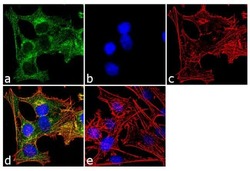
- Experimental details
- Immunofluorescence analysis of TAU was done on 70% confluent log phase SH-SY5Y cells. The cells were fixed with 4% paraformaldehyde for 10 minutes, permeabilized with 0.1% Triton™ X-100 for 10 minutes, and blocked with 1% BSA for 1 hour at room temperature. The cells were labeled with TAU (TAU-5) Mouse Monoclonal Antibody (Product # MA5-12808) at 2 µg/mL in 0.1% BSA and incubated for 3 hours at room temperature and then labeled with Goat anti-Mouse IgG (H+L) Superclonal™ Secondary Antibody, Alexa Fluor® 488 conjugate (Product # A28175) at a dilution of 1:2000 for 45 minutes at room temperature (Panel a: green). Nuclei (Panel b: blue) were stained with SlowFade® Gold Antifade Mountant with DAPI (Product # S36938). F-actin (Panel c: red) was stained with Alexa Fluor® 555 Rhodamine Phalloidin (Product # R415, 1:300). Panel d is a merged image showing cytoplasmic localization. Panel e is a no primary antibody control. The images were captured at 60X magnification.
- Submitted by
- Invitrogen Antibodies (provider)
- Main image
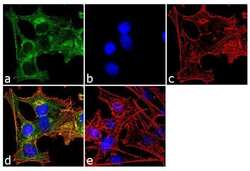
- Experimental details
- Immunofluorescence analysis of TAU was done on 70% confluent log phase SH-SY5Y cells. The cells were fixed with 4% paraformaldehyde for 10 minutes, permeabilized with 0.1% Triton™ X-100 for 10 minutes, and blocked with 1% BSA for 1 hour at room temperature. The cells were labeled with TAU (TAU-5) Mouse Monoclonal Antibody (Product # MA5-12808) at 2 µg/mL in 0.1% BSA and incubated for 3 hours at room temperature and then labeled with Goat anti-Mouse IgG (H+L) Superclonal™ Secondary Antibody, Alexa Fluor® 488 conjugate (Product # A28175) at a dilution of 1:2000 for 45 minutes at room temperature (Panel a: green). Nuclei (Panel b: blue) were stained with SlowFade® Gold Antifade Mountant with DAPI (Product # S36938). F-actin (Panel c: red) was stained with Alexa Fluor® 555 Rhodamine Phalloidin (Product # R415, 1:300). Panel d is a merged image showing cytoplasmic localization. Panel e is a no primary antibody control. The images were captured at 60X magnification.
Supportive validation
- Submitted by
- Invitrogen Antibodies (provider)
- Main image
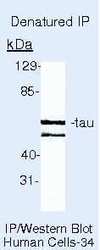
- Experimental details
- Immunoprecipitation of TAU using TAU Monoclonal Antibody (Product # MA5-12808) on denatured Human IMR-5 Cells.
Supportive validation
- Submitted by
- Invitrogen Antibodies (provider)
- Main image
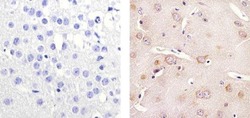
- Experimental details
- Immunohistochemistry analysis of TAU (TAU-5) showing staining in the cytoplasm of paraffin-embedded mouse brain tissue (right) compared to a negative control without primary antibody (left). To expose target proteins, antigen retrieval was performed using 10mM sodium citrate (pH 6.0), microwaved for 8-15 min. Following antigen retrieval, tissues were blocked in 3% H2O2-methanol for 15 min at room temperature, washed with ddH2O and PBS, and then probed with a TAU Antibody (TAU-5) Mouse Monoclonal Antibody (Product # MA5-12808) diluted in 3% BSA-PBS at a dilution of 1:100 for 1 hour at 37°C in a humidified chamber. Tissues were washed extensively in PBST and detection was performed using an HRP-conjugated secondary antibody followed by colorimetric detection using a DAB kit. Tissues were counterstained with hematoxylin and dehydrated with ethanol and xylene to prep for mounting.
- Submitted by
- Invitrogen Antibodies (provider)
- Main image
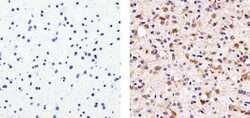
- Experimental details
- Immunohistochemistry analysis of TAU (TAU-5) showing staining in the cytoplasm of paraffin-embedded human astroglioma (right) compared to a negative control without primary antibody (left). To expose target proteins, antigen retrieval was performed using 10mM sodium citrate (pH 6.0), microwaved for 8-15 min. Following antigen retrieval, tissues were blocked in 3% H2O2-methanol for 15 min at room temperature, washed with ddH2O and PBS, and then probed with a TAU Antibody (TAU-5) Mouse Monoclonal Antibody (Product # MA5-12808) diluted in 3% BSA-PBS at a dilution of 1:100 for 1 hour at 37°C in a humidified chamber. Tissues were washed extensively in PBST and detection was performed using an HRP-conjugated secondary antibody followed by colorimetric detection using a DAB kit. Tissues were counterstained with hematoxylin and dehydrated with ethanol and xylene to prep for mounting.
Supportive validation
- Submitted by
- Invitrogen Antibodies (provider)
- Main image
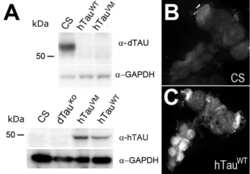
- Experimental details
- NULL
- Submitted by
- Invitrogen Antibodies (provider)
- Main image
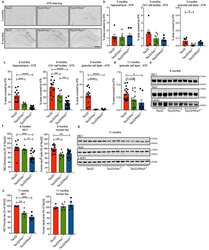
- Experimental details
- NULL
- Submitted by
- Invitrogen Antibodies (provider)
- Main image
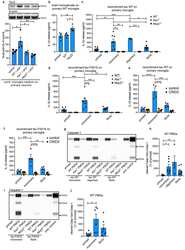
- Experimental details
- NULL
- Submitted by
- Invitrogen Antibodies (provider)
- Main image
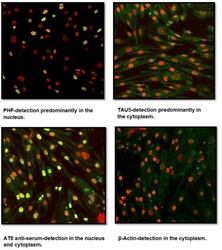
- Experimental details
- Figure 1 Confocal microscopy analysis of untransfected human fibroblasts. Cells isolated from a skin biopsy showed a positive reactivity for Tau5 (cytoplasm), PHF (nucleus), and AT8 anti-serum (cytoplasm and nucleus). Nuclei were stained with Sytox (in red), while Tau was detected through FITC conjugated to the secondary antibody (in green). Sytox/FITC signal overlap is observed in yellow.
- Submitted by
- Invitrogen Antibodies (provider)
- Main image

- Experimental details
- Figure 6 Assessment of Tau overexpression by Western blot. Total protein extracts from fibroblasts under distinct experimental conditions were subjected to immunodetection using Tau5 antibody. beta-actin immunodetection was performed as loading control. UnFs, untransfected fibroblasts; TFs, fibroblasts transfected with pVAX-Tau.
- Submitted by
- Invitrogen Antibodies (provider)
- Main image
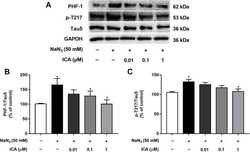
- Experimental details
- Figure 6 Effect of ICA on the phosphorylation level of Tau in NaN 3 -injured PC12 cells. (A) Representative bands showing PHF-1 and p-T217 in PC12 cells in the different groups. (B) Quantitative analysis of PHF-1 levels. (C) Quantitative analysis of p-T217 levels. Phosphorylated Tau was normalized to total Tau. The data are shown as the mean +- SEM, n = 5 (* P < 0.05 vs. the control group, # P < 0.05 vs. the NaN 3 group).
- Submitted by
- Invitrogen Antibodies (provider)
- Main image
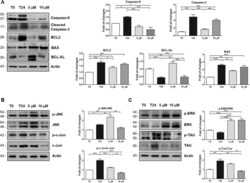
- Experimental details
- Fig. 6 Curcumin treatment prevents apoptotic and MAPK pathways activation in ex vivo model of retinal degeneration. A Representative western blots and relative quantifications showed the reduction of Caspase-9, cleaved-Caspases-3, BCL2, and BAX levels in retina homogenates caused by the 24 h pre-treatment of curcumin (5 and 10 muM) if compared to induced retinal degeneration at time 24. The BCL-XL level was significantly increased by 5 muM of curcumin administration. * P < 0.05, ** P < 0.01, *** P < 0.001, and **** P < 0.0001 [ n = 5]. Data were expressed as mean +- SEM. One-way ANOVA, Tukey's post hoc test. B , C Representative western blots and relative quantifications of JNK, c-Jun, ERK, and Tau. B Graphs indicated a significant augmented p-JNK/JNK and p-c-Jun/C-Jun ratios at time 24, reduced by curcumin administration; 5 muM of curcumin significantly increase p-JNK/JNK ratio if compared to other experimental conditions. C A significant decrease of p-ERK/ERK ratio at time 24 was caused by 5 and 10 muM of curcumin administration. The augmented p-Tau/Tau ratio observed at time 24 was reduced by curcumin treatment. * P < 0.05, ** P < 0.01, *** P < 0.001, and **** P < 0.0001 [ n = 5]. Data were expressed as mean +- SEM. One-way ANOVA, Tukey's post hoc test.
- Submitted by
- Invitrogen Antibodies (provider)
- Main image
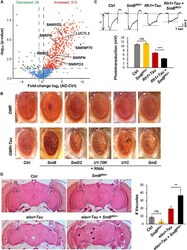
- Experimental details
- Figure 1. Tau Associates and Genetically Interacts with Spliceosomal Factors (A) Following coimmunoprecipitation, 1,065 Tau-associated proteins were identified from AD or control postmortem brain tissue homogenates (n = 4 each). Volcano plot highlights proteins showing >1.5-fold increased (red) or decreased (green) interactions with Tau in AD (all p < 0.05), including numerous ribonucleoproteins (p = 7.7 x 10 -5 ). Spliceosome components are denoted. See also Figure S1 , Tables S1 , and Data S1 , tabs i and ii. (B) Compared with controls (Ctrl, top left), Tau V337M expression in the eye ( GMR-GAL4 ) causes reduced eye size and roughened surface (bottom left: 1.98 +- 0.08, mean score +- SEM, n > 35 for all genotypes), and RNAi targeting spliceosome factors enhanced toxicity (bottom row, p < 0.0001: SmB , 3.67 +- 0.06; SmD2 , 4.00 +- 0.00; U1-70K , 4.04 +- 0.03; U1C , 3.92 +- 0.09; and SmE , 4.00 +- 0.00). RNAi lines were non-toxic when expressed independently (top row). See also Data S1 , tab iii. (C) Tau WT expression in the adult retina ( Rh1-GAL4 ) causes reduced electroretinogram (ERG) amplitude in 5-day-old flies, and this phenotype is enhanced in SmB MG heterozygotes (n > 10 for quantification). See also Figures S2A - S2C . (D) Pan-neuronal expression of Tau R406W ( elav-GAL4 ) causes progressive neuropil vacuolization (arrows) in hematoxylin and eosin-stained frontal brain sections in 10-day-old adult flies, and this phenotype is enhanced in SmB MG heterozygotes (n > 8
 Explore
Explore Validate
Validate Learn
Learn Western blot
Western blot Immunocytochemistry
Immunocytochemistry